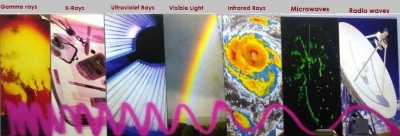
ELECTROMAGNETIC SPECTRUM
Energy spreads in waves of electromagnetic radiation, like the ripples on a pond. It travels through space at the speed of light, around 300,000 km/sec (186,000 miles/sec). Although energy always travels through space at the same speed, its wavelength (the distance between any two peaks or troughs of the waves) can vary. Short waves, such as X-rays, carry high amounts of energy that can penetrate the human body, while longer, lower energy waves, such as light cannot. Apart from visible light, all electromagnetic waves are invisible. Together these waves make up a continuous band of energy known as the electromagnetic spectrum.
GAMMA RAYS Gamma rays are produced by radioactivity, such as a nuclear explosion. They have a short wavelength and carry large amounts of energy. They are very harmful to humans, but are used to treat cancer by killing damaged cells.
X-RAYS These high-energy waves can pass through materials such as flesh and suitcase plastic, but not through bone or metal objects. This makes them a valuable tool for examining bones in hospitals and searching for weapons in airports.
ULTRAVIOLET RAYS With a slightly shorter wavelength than visible violet light, ultraviolet rays also carry more energy than visible light. Ultraviolet rays emitted by the Sun and tanning beds can damage skin not protected by sunblock, causing sunburn.
VISIBLE LIGHT The Sun emits most of its energy as visible light, which can be split into the colours of the rainbow. Earth’s atmosphere allows visible light through, while blocking more harmful wavelengths. Visible light is vital for life. Without it, plants could not grow.
INFRARED RAYS Just beyond the visible red in the spectrum is infrared, which can be felt as heat. Often, when heat energy moves it is transported by infrared waves. Infrared satellite images of Earth’s surface are used by weather forecasters to determine temperatures.
MICROWAVES These have much longer wavelengths than visible light. Longer wavelength microwaves are used in a microwave oven. Shorter wavelength microwaves are used in radar systems that help ships and planes navigate by locating traffic and obstacles.
RADIO WAVES These are the longest in the spectrum. Many forms of communication, such as TV, mobile phones, and radio, use radio waves, with different wavelengths carrying different signals. Radio waves from outer space are picked up by radio telescopes and used in studies of the Universe.
WAVELENGTHS The difference between wavelengths at either end of the electromagnetic spectrum is immense. The wavelength of gamma rays is only a fraction of the size of an atom, while radio waves at the opposite end of the spectrum can be thousands of kilometres long.
Picture Credit : Google




